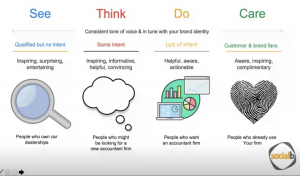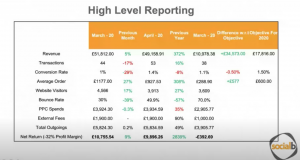Blogs are an amazing content asset and when used in the right ways can draw people to your website, build trust with your brand and influence them to purchase.
But do you ever feel like you are just making blogs because you know you should? Ever wonder if people love them but never actually do anything afterwards? Knowing the purpose or desired end result of your blog is crucial to understanding its performance.
When it comes to creating blogs that convert, whether you’re an experienced blog writer for your organisation, you think you should be blogging or you’ve tried it, and it didn’t work, it’s fact that blogs can generate business and attract your target audience.
Did you know you’re likely to get 3 times more leads from blogging and creating content than ads?
Before we jump to the why and how of creating blogs that convert, when it comes to online marketing as businesses, we are here to achieve our marketing objectives. This may be to increase sales, sign ups or achieve better conversion rates, whatever your objective is, it’s the reason we are on the internet.
If you take your marketing hat off and put your consumer shoes on, whether that’s B2C or B2B, as consumers we don’t really care what an organisation’s marketing objectives are! We simply want to find an answer to a question or a solution to a problem and a business to help us achieve that.
We all want to reach our marketing objectives with least amount of input. In this case, driving the right traffic and the right audience to your website. One of the best ways to do this is through blogs, video content and podcasts.
Contents
How to establish your blog objective
When it comes to blog content, a good framework to use is the See, Think, Do & Care theory from Google.
As a business we want to target people who are ready to purchase or the ‘Do’ part of the framework. That makes sense, right? But finding these ready to buy consumers accounts for only 10% of your audience. It’s believed that 30% of your target audience are in the ‘See’ aspect and 60% in the ‘Think’. This means you are potentially missing out on 90% of you target audience by heading straight to the ‘Do’.
If you put your consumer shoes on again, think about how you search for something; we start intent. We might ask a question, google a thought or want to find out how to do something and 9 out 10 times this leads us to land on a blog post.
This is where the opportunity lies for you to create blogs that convert, and when you include the right call to actions in your blog to meet your marketing objective, you begin to move your target audience closer to becoming a customer and generate business.
See, Think & Do is all about listening, but there are other ways and tools for listening to your customers:-
- Customer Service Team – Listen to them talking to customers and find the exact language, key terms and phrases or questions they are asking and turn this into blog content. Make sure you use this in an un-summarised format; this is called the voice of customer of voice of customer data.
- Data Tools – Google Analytics, Google Search Console, Google Keyword Planner.
- Consumers Direct – Forums, product reviews or blog comments, what they like/don’t like about products.
- Don’t be Afraid to Ask – Discover what challenges potential customers face or what drove them to contact you.
By answering these questions in your blog posts, when users with intent search in Google, your blog will drive the right people at the right time to your website.
When creating content, a great blog post moves people to say yes to something. Bear in mind that they are probably unaware of your brand so educate them, entertain them or inspire them with clear call to actions blogs will generate business and get more of that 90% of intent traffic.
How to pick the right title
Crafting the right title for your blog is fundamental to: –
- Be found on the search engines.
- Entice users to click on your blog and want to find out more.
- Not just promise, but make sure you deliver what is says!
Once you’ve done the keyword research as above, you should have a plethora of information to pick the right blog title that potential customers will want to read.
Writing to convert
Remember; focus on intent. At this point the user doesn’t want to buy they want to get an answer to the question or solve a problem. Writing a blog to convert should not sell but engage your target audience with the aim of getting the user to say yes to your call to action.
The length of your blog is also key, a blog needs to serve the customer and answer their question. A handy formula is PAS (Pain, Agitate and provide a Solution). Your content should cover these in this order, rather than jumping straight to the solution.
As we often skim read content, whilst a chunky blog is good for search engines think about the layout, keep paragraphs short to help with easy reading, use bullet points, but remember you’re not selling here.
Keep Call to Actions simple and to a minimum; too many and you can confuse the customer and they’re less likely to click. Focus on the intent and get them ready to convert.
Spending time on a blog post is a real investment and can take up to 20 hours. Take your time, use your research, think about your headline. Highly crafted and though out blogs are a valuable piece content.
Measurement at its best
Make sure you have a starting point to measure from, look at your Google Analytics and see where your traffic is coming from, what’s the bounce rate and conversion rate? This way you can see the effect of your blogging efforts and what works.
If you are already blogging but not seeing conversions, note what traffic you are getting and where it is coming from to enable you to see improvements.
Measurement at its best is focusing on what is important to you. Google Analytics has an enormous amount of data available. Start by thinking about what’s important to your organisation it may include:-
- Sales
- Number of leads
- Conversion rate,
- Cost per enquiry
- Cost per sale.
Once you’ve got your KPIs, you can set up a Google Dashboard which will save you time.
Tracking performance – reporting for you and your boss
When reporting to management or your senior team, many people over report to demonstrate what they’ve been doing. That’s all good but a simple high level report as this example shows is instantly valuable and shows the outcomes of the work you put in and a positive return on investment.
Finally, when creating blogs that convert don’t have a sales mindset but have a value mindset and think about the value of marketing.
If you’d like to know more about blog writing and creating blogs that convert why not join our one-hour live webinar ‘Creating Blogs That Convert‘ get in touch or take a look at the Resources section on our website for a host of online marketing information.








